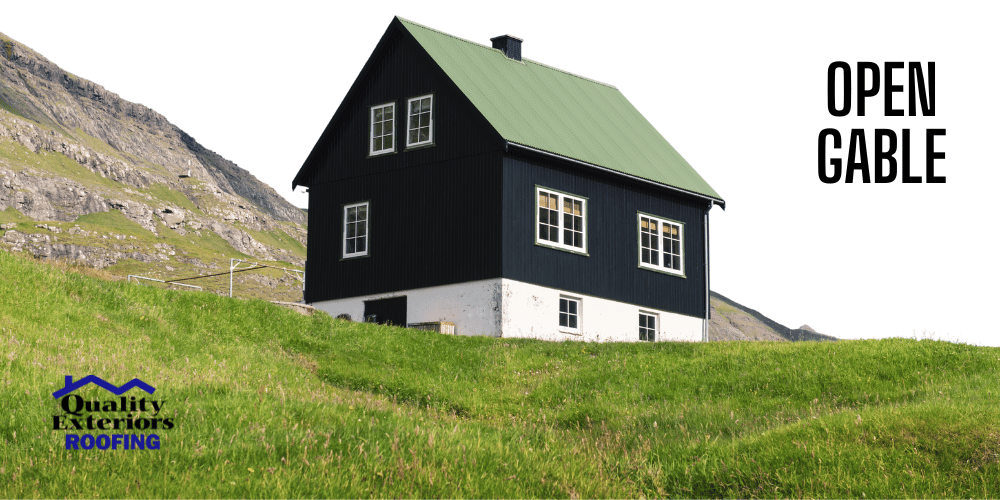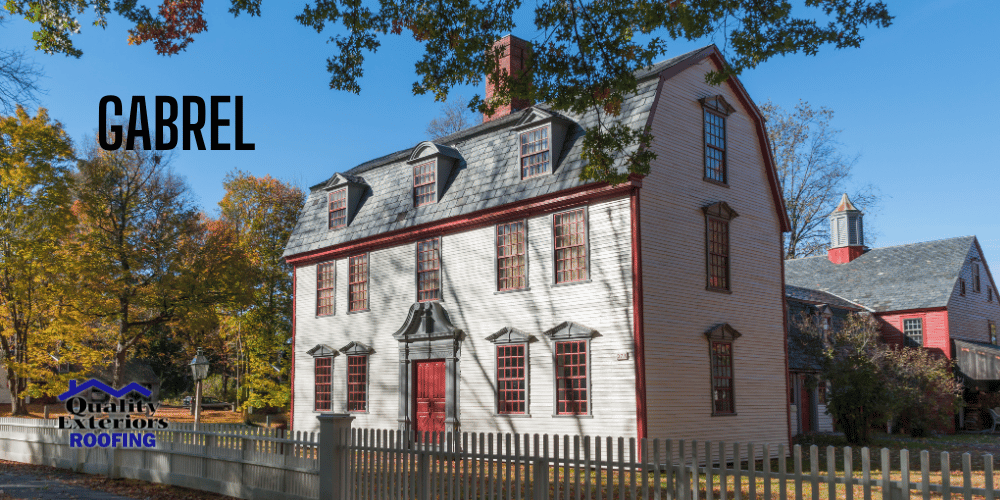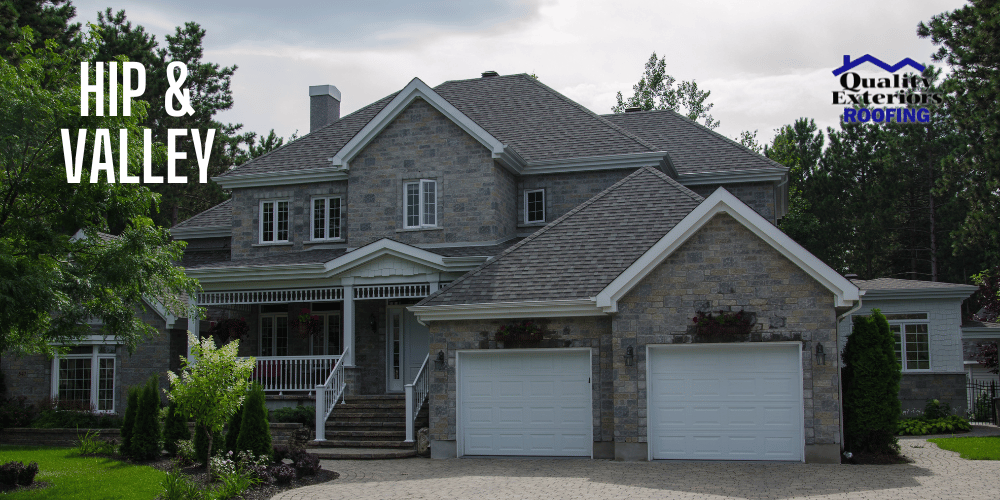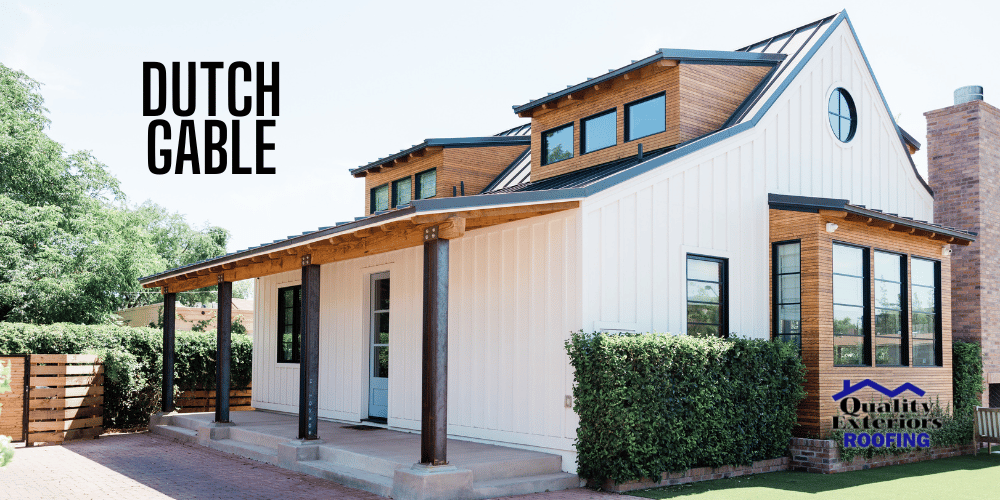There are several different types of roofs that are used on homes and businesses today, but two types of roofs continue to stand out among the competition: gable and hip roofs. As a professional roofing contractor, Quality Exteriors has knowledge and expertise with both roof styles. If you’re trying to decide between a hip and gable roof for your roofing project, our roofing professionals can help you determine which is best suitable for your home or office. We’ll go over the pros and cons of a hip roof vs. gable roof and explain the various types of both types of roofs.
What is a Gable Roof?
A gable roof, also called a pitched roof, is a common type of roof used for home and building designs.
Gable roofs are characterized by their triangular shape. For the typical gable roof design, you’ll see two vertical sides that slope downward and meet in the center of the house. With gabled roofs, the ends can either be open, forming an open gable roof, or they can be enclosed, creating a box gable roof.
Gable roofs typically work well for most home styles and can also be combined with another type of roof, depending on the layout and size of the home.
Gable roofs continue to be one of the most popular styles, and for good reason. A gabled roof requires minimal maintenance, can be installed using basic roofing materials, and easily sheds ice and water.
Although they seem simple, there’s more to gable roofs than you’d think. We’ll dive into what a gable roof consists of, the types of gable roofs, and gable roof advantages later in this post.
Types of Gable Roofs
While a gable roof is a basic design, homeowners are able to get more specific depending on how they would prefer their gable roof to look or function. Some of the most common types of gable roofs include:
Open Gable Roof

An open gable roof is a standard gable consisting of two vertical sides meeting at a point and leaving the ends open.
Box Gable Roof
This design is very similar to a standard gable roof, but the triangular section is more defined. It has the basic vertical sides that meet at a point, but then by using a small hip roof or cut out, the end of the gable is closed.
Cross Gable Roof
A cross-gabled roof is better for homes that have an off-shoot area. With a cross-gable roof, the design will have two or more gable rooflines that intersect at an angle, most frequently with two ridges placed perpendicular to one another.
Dutch Gable Roof
A Dutch gable roof is a hybrid of the standard hip and gable roofs where the gable roof is located on top of the hip roof. In terms of space and curb appeal, gable roofs, with the addition, provide more of both!
Flying Gable Roof
The flying gable roof looks like the standard gable roof. However, the end protrudes further, coming to a point similar to the brim of a hat. This type of gable roof may be found in a mid-century modern home.
Gambrel Roof
The gambrel roof is a hybrid of a few roof types. When most consumers think of gambrel roofs, they imagine a barn roof style. Gambrel roofs have two gable roof lines, one on each side, with multiple sloping angles to wrap around the building instead of one steep roof slope.

Pros of Gable Roofs
The advantages of gable roofs include the following:
- Provides more attic space with vaulted ceilings
- More affordable than hip roofs
- Can be easily combined with other roof types to create unique designs, such as the jerkin-head roof
- Additional ventilation is provided by gable vents
- Simple design and roof installation
- Can be created using virtually any roofing material
- Uses fewer roofing materials than the standard hip roof design
Cons of Gable Roofs
The disadvantages of gable roofs include the following:
- High winds can easily lift the edges, causing damage
- Plain design compared to hip roofs and other types of roofs
What is a Hip Roof?
Hip roof designs are slopestyle. This means that all four roof sides slope downward from the peak. The walls are underneath the roof’s eaves, which gives the roof a low pitch.
Because the standard hip roof doesn’t have vertical ends, this causes the edges to slope inward to the adjacent sloping angles or ridges. When the two adjacent roof slopes form a ridge, the angle they create is called a roof “hip.”
Hip roof designs are commonly found on church steeples or other buildings that have a high pitch. They are also popular in homes in the suburbs because they are simple to build. The walls under the roof are all the same height, making construction simpler.
Types of Hip Roofs
There isn’t as much of a variety of hip roofs as there are gable roofs, but there are some for homeowners that want to stylize their hipped roof or have a bigger home where they would still like for hipped roofs to be incorporated on various areas of their home.
Cross Hip Roof
Similar to a crossed gable roof, the cross-hipped roof is two roofs meeting at a 90-degree angle, creating a seam that is referred to as the ‘valley.’ A cross-hipped roof is often L-shaped.
Half Hip Roof
The half-hipped roof is a standard hip that has two shorter sides that create eaves, more than the length of a standard hip roof. Half-hipped roofs are essentially gable roof with a small hip roof section.
This type of hip roof is sometimes referred to as a jerkinhead roof or a clipped gable roof.
Hip and Valley

Hip and valley roofs combine two hips meeting at a valley, meaning that it will have more than one point. Depending on the layout of the house, there can be multiple points.
Simple Hip Roof
This style has four sloped sides meeting in the middle and forming a low-sloped roof. Simple hip roofs are also known as “standard hip” roofs.
Mansard Roof
A mansard roof is a hip roof with two different sloping angles, with the bottom angle being more steep than the top angle.
Tented Roof
This type of roof is one of the more popular roof styles for churches. It is a polygonal or pyramid roof style with adjacent slopes that come together at the peak.
Pavilion Roof
Pavilion roofs are the same as an open gable roof- a square hip roof with a square structure that creates a pyramid roof.
Pros of Hip Roofs
The advantages of a hip roof design include the following:
- Withstand snow, ice, and high winds better than gable roofs
- Allows for gutters on each side
- Better curb appeal and a more modern look
- Combines with other roof styles easily
- Good energy efficiency
- Self-bracing (as opposed to diagonal bracing)
Cons of Hip Roofs
The disadvantages of a hip roof design include the following:
- More expensive design and installation than gable roofs
- Less attic space
- Dormers are prone to water leaks
- The hip roof requires more roofing materials
- Less air ventilation
What are Factors to Consider With Hip and Gable Roofs?

It’s always important to research and weigh the pros and cons of the various roofing style options. However, there are many things to consider before choosing your desired roof type.
Some of the other factors to consider when making your decision on hip roof vs. gable roof include:
Required Roof Maintenance
Is it going to be easy or difficult to maintain your new roof?
Sadly, many homeowners don’t think about their roofs until a bad storm or disaster occurs. However, regular maintenance is key to prolonging the life of your roof and ensuring that it protects you and your family for years to come.
Maintenance can be more difficult on a gable roof because it is often steeper. However, a gable roof will also shed water and ice more efficiently than its lower-sloped roof counterparts.
On the flip side, a hip roof requires more maintenance to ensure that its gutters are clear of leaves and other debris.
So, considering the long-term maintenance commitment for both a gable and hip roof is essential.
Cost
When deciding between a hip roof and gable roof, you’ll want to ensure that you can afford the roof installation, maintenance, and future repairs.
Because of its basic design, a gable roof is typically pretty simple to repair or replace. Hip roofs, on the other hand, might need premium installation and maintenance over time, depending on the style.
Style Longevity
There’s a delicate balance between selecting a trendy roof style and a standard one. You don’t want your home to stick out like a sore thumb, but you also want to select a roof that you love.
Roofing Materials
Roof style and materials are two very different things. Some materials work better with your roof’s slope than others. Various materials also come with their own levels of roofing maintenance, varying lifespans, and added costs, over time.
While we’re happy to discuss the most common roof styles, you’ll really need to speak with one of our roofing professionals to determine whether or not your material selection will work with your style selection.
Added Value to Property
Any new roof, when installed properly, is going to improve your home’s value. If you’re planning on selling your home or business in the near future, our roofing installers can help you determine which roof type is going to bring the best return on investment.
Hip Roof vs. Gable Roof: Call Our Bossier City Roof Installers
Selecting the best roof type for your project can be overwhelming, but it doesn’t have to be. Our professional roofers have been serving our local communities since 1982. We have built a reputation for honest, high-quality work and are happy to help our community members ensure that they’ve selected the best roofing style for their home or business.
When you’re in need of a new roof, the professionals at Quality Exteriors can help walk you through the process and decide which roof style would best suit your desires. We’re licensed and insured and offer customer satisfaction guarantees.
Our roofing pros currently service the following areas:
- Shreveport roofing
- Bossier City roofing
- South Louisiana roofing
- Bryant, Arkansas roofing
- East Texas roofing


